小升初英语知识点归纳总结精编版
小升初英语笔记整理归纳重点
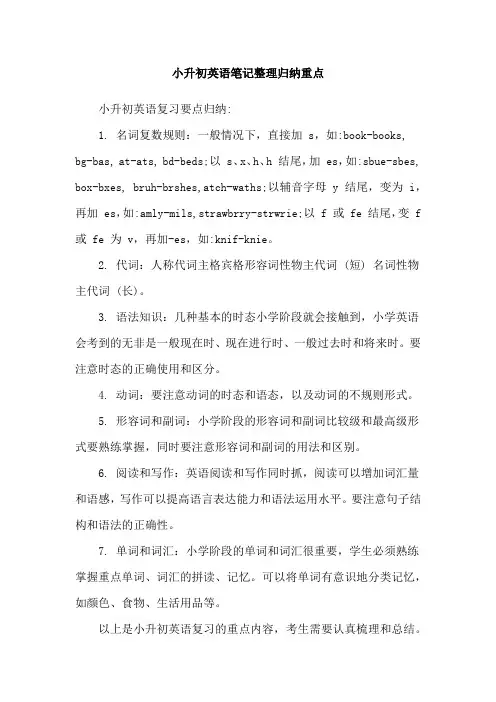
小升初英语笔记整理归纳重点
小升初英语复习要点归纳:
1. 名词复数规则:一般情况下,直接加 s,如:book-books, bg-bas, at-ats, bd-beds;以 s、x、h、h 结尾,加 es,如:sbue-sbes, box-bxes, bruh-brshes,atch-waths;以辅音字母 y 结尾,变为 i,再加 es,如:amly-mils,strawbrry-strwrie;以 f 或 fe 结尾,变 f 或 fe 为 v,再加-es,如:knif-knie。
2. 代词:人称代词主格宾格形容词性物主代词 (短) 名词性物主代词 (长)。
3. 语法知识:几种基本的时态小学阶段就会接触到,小学英语会考到的无非是一般现在时、现在进行时、一般过去时和将来时。
要注意时态的正确使用和区分。
4. 动词:要注意动词的时态和语态,以及动词的不规则形式。
5. 形容词和副词:小学阶段的形容词和副词比较级和最高级形式要熟练掌握,同时要注意形容词和副词的用法和区别。
6. 阅读和写作:英语阅读和写作同时抓,阅读可以增加词汇量和语感,写作可以提高语言表达能力和语法运用水平。
要注意句子结构和语法的正确性。
7. 单词和词汇:小学阶段的单词和词汇很重要,学生必须熟练掌握重点单词、词汇的拼读、记忆。
可以将单词有意识地分类记忆,如颜色、食物、生活用品等。
以上是小升初英语复习的重点内容,考生需要认真梳理和总结。
同时,要注意练习和模拟考试,不断提高自己的英语水平和应试能力。
小升初英语知识点总结重点
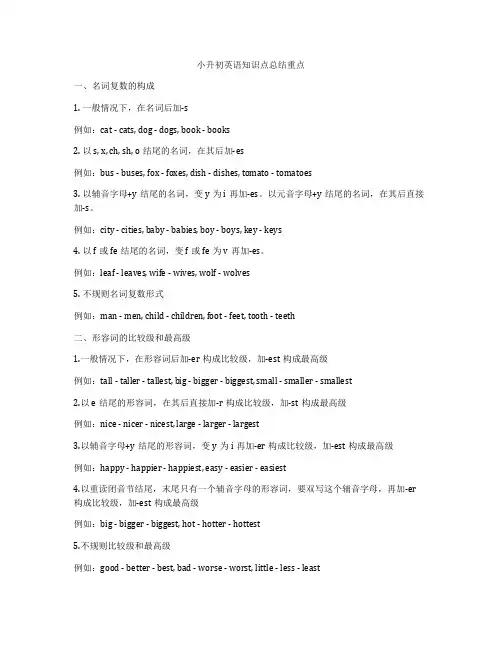
小升初英语知识点总结重点一、名词复数的构成1. 一般情况下,在名词后加-s例如:cat - cats, dog - dogs, book - books2. 以s, x, ch, sh, o结尾的名词,在其后加-es例如:bus - buses, fox - foxes, dish - dishes, tomato - tomatoes3. 以辅音字母+y结尾的名词,变y为i再加-es。
以元音字母+y结尾的名词,在其后直接加-s。
例如:city - cities, baby - babies, boy - boys, key - keys4. 以f或fe结尾的名词,变f或fe为v再加-es。
例如:leaf - leaves, wife - wives, wolf - wolves5. 不规则名词复数形式例如:man - men, child - children, foot - feet, tooth - teeth二、形容词的比较级和最高级1.一般情况下,在形容词后加-er构成比较级,加-est构成最高级例如:tall - taller - tallest, big - bigger - biggest, small - smaller - smallest2.以e结尾的形容词,在其后直接加-r构成比较级,加-st构成最高级例如:nice - nicer - nicest, large - larger - largest3.以辅音字母+y结尾的形容词,变y为i再加-er构成比较级,加-est构成最高级例如:happy - happier - happiest, easy - easier - easiest4.以重读闭音节结尾,末尾只有一个辅音字母的形容词,要双写这个辅音字母,再加-er 构成比较级,加-est构成最高级例如:big - bigger - biggest, hot - hotter - hottest5.不规则比较级和最高级例如:good - better - best, bad - worse - worst, little - less - least三、动词的时态1. 一般现在时:主语 + 动词原形例如:I go to school every day.2. 现在进行时:主语 + am/is/are + 动词-ing形式例如:She is watching TV now.3. 一般过去时:主语 + 动词过去式例如:He played football yesterday.4. 过去进行时:主语 + was/were + 动词-ing形式例如:We were studying English at this time yesterday.5. 一般将来时:主语 + will + 动词原形例如:I will go to Beijing tomorrow.6. 现在完成时:主语 + have/has + 动词过去分词例如:She has finished her homework.7. 过去完成时:主语 + had + 动词过去分词例如:I had completed my work before she arrived.四、数词1.基数词:表示数量的词例如:one, two, three, four, five...2.序数词:表示顺序的词例如:first, second, third, fourth, fifth...3.分数:表示分数的词例如:one third, two fifths, three quarters...五、代词1.人称代词:表示人的身份或者代替人的词例如:I, you, he, she, it, we, they2.物主代词:表示所属关系的代词例如:my, your, his, her, its, our, their3.反身代词:表示动作的主语和宾语指同一人或事物的代词例如:myself, yourself, himself, herself, itself, ourselves, themselves 4.指示代词:表示指向的代词例如:this, that, these, those5.疑问代词:表示疑问的代词例如:who, whom, whose, which, what六、副词1.时间副词:表示时间的副词例如:now, then, soon, today, yesterday, tomorrow...2.地点副词:表示地点的副词例如:here, there, everywhere, anywhere, nowhere...3.方式副词:表示方式的副词例如:slowly, quickly, carefully, loudly, quietly...4.程度副词:表示程度的副词例如:very, quite, rather, too, enough...七、连接词1.并列连词:连接两个并列成分例如:and, but, or, so, for, nor, yet2.从属连词:引导并引导从句例如:when, where, if, because, although, while, since八、冠词1.定冠词:表示特指的冠词例如:the2.不定冠词:表示泛指的冠词例如:a, an九、情态动词1.can:表示能力、许可例如:I can swim. Can I go out?2.could:过去式,表示过去的能力、许可例如:I could swim. Could I go out?3.may:表示许可、可能例如:May I go out? It may rain tomorrow. 4.might:表示可能性例如:It might rain tomorrow.5.must:表示肯定、必须例如:You must do your homework.6.should:应该例如:You should listen to your parents.7.will:将要例如:I will go to Beijing tomorrow.十、介词1.表示时间的介词例如:at, in, on, during, by, for, from, to2.表示地点的介词例如:in, on, at, under, over, behind, in front of 3.表示方式的介词例如:by, with, like, as4.表示原因的介词例如:because of, due to, owing to以上就是小升初英语知识点总结,希朋友们认真学习,掌握好这些知识点,提高英语水平。
史上最全的小升初英语必考知识点大全
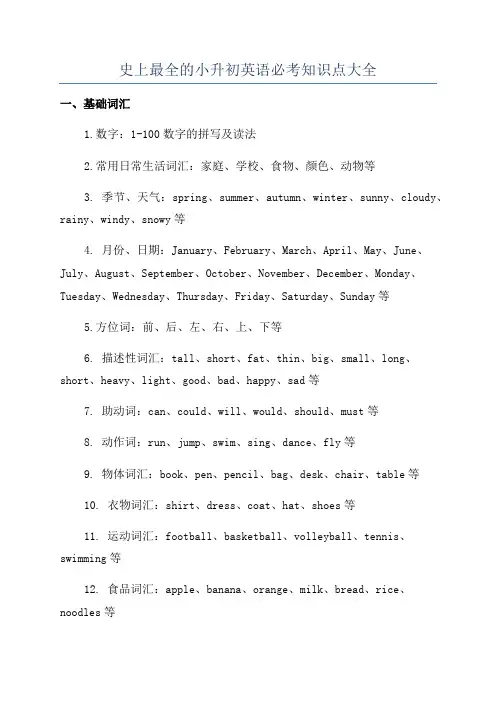
史上最全的小升初英语必考知识点大全一、基础词汇1.数字:1-100数字的拼写及读法2.常用日常生活词汇:家庭、学校、食物、颜色、动物等3. 季节、天气:spring、summer、autumn、winter、sunny、cloudy、rainy、windy、snowy等4. 月份、日期:January、February、March、April、May、June、July、August、September、October、November、December、Monday、Tuesday、Wednesday、Thursday、Friday、Saturday、Sunday等5.方位词:前、后、左、右、上、下等6. 描述性词汇:tall、short、fat、thin、big、small、long、short、heavy、light、good、bad、happy、sad等7. 助动词:can、could、will、would、should、must等8. 动作词:run、jump、swim、sing、dance、fly等9. 物体词汇:book、pen、pencil、bag、desk、chair、table等10. 衣物词汇:shirt、dress、coat、hat、shoes等11. 运动词汇:football、basketball、volleyball、tennis、swimming等12. 食品词汇:apple、banana、orange、milk、bread、rice、noodles等二、语法知识1.时态:一般现在时、一般过去时、一般将来时、现在进行时等2.名词单复数:可数名词和不可数名词的区分3. 冠词:a/an、the的用法4.代词:主格、宾格、所有格等5.形容词和副词的比较级和最高级:比较级、最高级的构成及用法6. 冠词:a、an、the的用法7.状语从句:时间状语从句、地点状语从句、原因状语从句等8. 定语从句和定语从句中关系代词的使用:that、which、who、whom、whose等9. 情态动词的用法:can、could、may、might、must、should、will等三、阅读理解1.短文理解:包括对短文的主旨、细节、主题等进行理解和推断2.阅读策略:如猜词法、上下文理解、主题理解等技巧3.阅读题型:选择题、判断题、填空题等不同类型的问题四、写作表达1.句子构成:主语、谓语、宾语、状语等句子成分的构成2.写作技巧:描述人物、描述动物、描述事物等写作技巧3.话题表达:日常生活、学习生活、周末活动等常见话题的表达方式。
史上最全的小升初英语必考知识点汇总
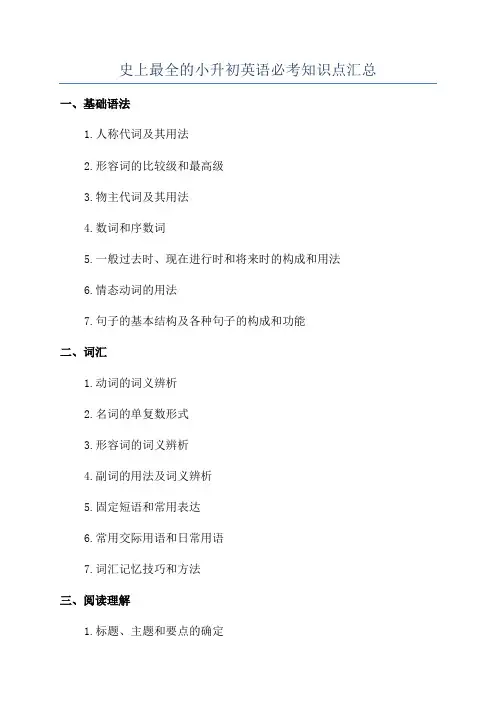
史上最全的小升初英语必考知识点汇总
一、基础语法
1.人称代词及其用法
2.形容词的比较级和最高级
3.物主代词及其用法
4.数词和序数词
5.一般过去时、现在进行时和将来时的构成和用法
6.情态动词的用法
7.句子的基本结构及各种句子的构成和功能
二、词汇
1.动词的词义辨析
2.名词的单复数形式
3.形容词的词义辨析
4.副词的用法及词义辨析
5.固定短语和常用表达
6.常用交际用语和日常用语
7.词汇记忆技巧和方法
三、阅读理解
1.标题、主题和要点的确定
2.速读和精读的技巧和方法
3.阅读技巧和策略
4.根据上下文理解生词
5.语法知识和词汇积累对阅读理解的帮助
6.能根据语境推测词义和句意
7.能够理解故事和文章的基本情节和主旨
四、写作
1.书面表达的格式和要求
2.逻辑思维和组织能力
3.简单句和复合句的写法
4.高频词汇和短语的运用
5.书写规范和语法正确性
6.表达自己的观点和观察力
7.提高写作水平的方法和技巧
五、听力
1.基本语音和语调
2.句子的语法结构和逻辑意义
3.句子的主题、中心和重点
4.通过听觉理解词意和句意
5.能够听懂对话和短文
6.能够根据听到的信息回答问题
7.提高听力技能的方法和技巧
这些知识点是小升初英语考试中必备的基础知识点,准备这些知识点对于顺利通过小升初英语考试有很大的帮助。
希望以上内容能对大家有所帮助,祝愿大家在小升初英语考试中取得优异的成绩!。
小升初必考英语知识点总结

小升初必考英语知识点总结一、基本句型1. 主语+谓语She is singing.2. 主语+谓语+宾语They are playing basketball.3. 主语+谓语+间接宾语+直接宾语He gave me a present.4. 主语+谓语+宾语+宾补She made me happy.5. 祈使句Open the door.6. There be 句型There is a book on the desk.7. 主系表结构She looks happy.8. 被动语态The book was read by me.9. 疑问句Do you like English?10. 倒装句Not only does he play basketball, but also he plays football.二、名词1. 可数名词和不可数名词a cup of tea, two bags of rice2. 名词的所有格my father's car3. 名词的单复数a book, two books4. 特殊名词的复数形式child-children, woman-women5. 特殊名词的不可数名词形式news, information6. 特殊名词的复合名词形式forget-me-not, passer-by三、冠词1. 定冠词和不定冠词a book, the book2. 不加冠词的情况He is a student.3. 特殊用法once upon a time四、代词1. 人称代词I, you, he, she, it, we, they2. 物主代词my, your, his, her, its, our, their3. 反身代词myself, yourself, himself, herself, itself, ourselves, themselves 4. 特殊用法one another, each other五、动词1. 一般现在时He plays basketball every day.2. 一般过去时I played computer games yesterday.3. 一般将来时I will go to the park tomorrow.4. 现在进行时She is reading a book now.5. 过去进行时He was playing basketball at this time yesterday.6. 情态动词can, may, must, should, need7. 动词的不定式to do, to be8. 动词的-ing形式reading, playing9. 动词的完成时I have read that book.10. 动词的被动语态The book was read by me.11. 及物动词和不及物动词I like singing.六、形容词和副词1. 形容词的比较级和最高级big-bigger-biggest2. 副词的用法She sings well.3. 物主形容词my, your, his, her, its, our, their4. 特殊形容词和副词good-better-best, well-better-best七、介词1. in, on, at的用法in the classroom, on the desk, at home2. 特殊介词的用法under, over, between, among3. 介词短语in front of, next to, to the left of4. 介词词组on time, in time八、连词1. and, but, or的用法She likes playing basketball and football.2. because, so的用法He is tired because he works hard.3. 特殊连词的用法either...or, neither...nor, not only...but also...九、数词1. 基数词和序数词one, first2. 特殊数词的用法the first of October, one and a half 3. 特殊用法three times a week, two hours' time十、时间1. 日常时间的表达at seven o'clock, in the morning2. 一般现在时表示的未来情况I leave for Beijing tomorrow.3. 特殊时间状语的用法last Sunday, next Tuesday十一、情态动词1. can, may, must, shouldI can swim.2. 特殊情态动词的用法would like, need3. 特殊用法had better, have to十二、虚拟语气1. if引导的虚拟条件句If I were you, I would go now.2. wish引导的虚拟句I wish I were a bird.3. 特殊用法It's high time, If only十三、疑问句和感叹句1. 一般疑问句Do you like English?2. 特殊疑问句What's your name?3.感叹句What a nice day it is!四、定语和被定语1. 定语的位置和形式the red book, the book on the desk2. 被定语的位置和形式a city of the world, a boy with big eyes3. 特殊用法a cup of tea, the mother of all rivers 十五、主谓一致1. 就近原则Neither she nor I am good at singing.2. 特殊用法There be 句型十六、宾语从句1. 特殊宾语从句的引导词I know who the man is.2. 特殊宾语从句的时态I think he will come soon.十七、主语从句1. 特殊主语从句的引导词What you have said is true.2. 特殊主语从句的时态It's clear that they have won the game. 十八、定语从句1. 特殊定语从句的引导词The boy who is swimming is my friend.2. 特殊定语从句的时态I have lost the pen that you gave me.十九、状语从句1. 时间状语从句When the bell rang, we stopped working.2. 地点状语从句Where there is a will, there is a way.3. 原因状语从句Because he was ill, he didn't go to work.4. 条件状语从句If I were you, I would go now.5. 结果状语从句It's so late that we can't go out.六、语音1. 单词中元音的发音cake, team2. 单词中辅音的发音break, cream3. 单词重读音节的规律beautiful, comfortable4. 特殊音标的发音ai, ee, th七、词汇1. 同义词happy-glad, big-large2. 反义词happy-sad, big-small3. 同音词see-sea, for-four4. 词根act, behave5. 词缀happy-unhappy, Sunday-weekend 8、语法1. 句子成分的转换He doesn't like playing basketball. Playing basketball is not liked by him.2. 句子类型的转换She can swim. - Can she swim?十九、阅读1. 阅读理解阅读短文,回答问题。
小升初英语必背知识总复习总结
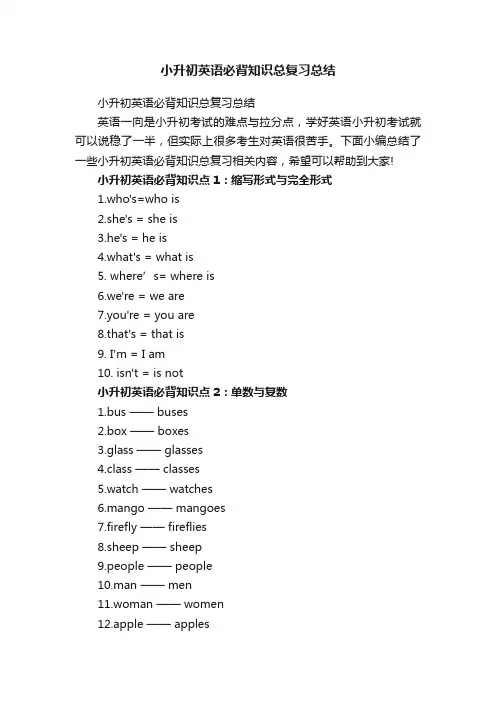
小升初英语必背知识总复习总结小升初英语必背知识总复习总结英语一向是小升初考试的难点与拉分点,学好英语小升初考试就可以说稳了一半,但实际上很多考生对英语很苦手。
下面小编总结了一些小升初英语必背知识总复习相关内容,希望可以帮助到大家!小升初英语必背知识点1:缩写形式与完全形式1.who's=who is2.she's = she is3.he's = he is4.what's = what is5. where’s= where is6.we're = we are7.you're = you are8.that's = that is9. I'm = I am10. isn't = is not小升初英语必背知识点2:单数与复数1.bus —— buses2.box —— boxes3.glass —— glasses4.class —— classes5.watch —— watches6.mango —— mangoes7.firefly —— fireflies8.sheep —— sheep9.people —— people10.man —— men11.woman —— women12.apple —— apples13.family —— families14.library —— libraries15.baby —— babies小升初英语必背知识点3:反义词1.same —— different2.new ——old3.old ——young4.short —— long5.big ——small6.tall —— short7.yes —— no8.open —— close9.hot —— cold10.here —— there小升初英语必背知识点4:近义词1. desk—— table2. like—— love3. often—— usually4. start—— begin5. great—— good小升初英语必背知识点5:同音词1. to too 、 two2. right write3. no know4. for four5. hear here6. I eye7. see (C) sea8. son sun9. be (B) bee10. there their11. U you12. Y why13. by buy 、 bye14. pair pear15. R are16. whose who's17. aunt aren't。
小升初英语重点知识点总结
小升初英语重点知识点总结小升初英语重点知识点总结篇一1.人称代词主格:I we you she he it they宾格:me us you her him it them形容词性物主代词:my our your her his its their名词性物主代词:mine ours yours hers his its theirs2.形容词和副词的比较(1) 一般在形容词或副词后+erolder ,taller, longer, stronger(2) 多音节词前+moremore interesting, etc.(3) 双写较后一个字母,再+erbigger fatter, etc.(4) 把y变i,再+erheavier, earlier(5) 不规则变化:well-better, much/many-more, etc.3.可数词的复数形式Most nouns + s abook –booksNouns ending in aconsonant +y - y+ ies a story—storiesNouns ending in s,sh, ch or x + es a glass—glasses a watch-watchesNouns ending in o+s or +es a piano—pianos a mango—mangoesNouns ending in for fe - f or fe +ves a knife –knives a shelf-shelves4.不可数名词(单复数不变)bread, rice, water ,juice等。
5.缩略形式I’m= I a,you’re = you are,she’s= she is,he’s = he isit’s= it is,who’s =who is,can’t =can not,isn’t=is not等。
小升初英语重点知识点总结篇二一、形式上不留任何痕迹一般说来,句子中的某些成分被省略后,形式上不保留任何痕迹,只能从意义上来理解。
完整版小升初英语知识点归纳总结(一)
完整版小升初英语知识点归纳总结(一)随着小学阶段的结束,小升初的到来让许多家长和孩子们感到焦虑。
尤其是在英语学科中,缺少系统性学习的儿童,将面临着更大的压力。
本文将为大家梳理完整版小升初英语知识点。
一、基础语法1. 介词的用法。
常用介词有 on,in,at,with,for 等。
其使用方式通常取决于句子的语境和含义。
2. 时态的使用。
英语语态主要分为现在时、过去时和将来时。
单词的时间性在句子中的使用和运用需要通过语法知识理解和掌握。
3. 词汇的分类和用法。
英语单词可以根据含义和用途分为不同的类别,如动词,名词,形容词等。
了解这些分类和使用方法是克服英语语言障碍的重要步骤。
二、阅读理解1. 短文阅读。
短文阅读是小学生英语学习的重要一环,其目的是让学生理解阅读材料的主要内容和一般意义。
在练习时,应该注重对文章重点词汇的理解和记忆。
2. 阅读理解技巧。
在进行阅读理解时,孩子们应该逐句阅读,理解文章的主要内容,并识别文字中的生词。
此外,还可以在阅读过程中标记主题句、关键词和其他需要关注的信息。
三、口语表达1. 基本句型。
小升初英语口语基本句型较简单。
学生应该能够正确使用主语、谓语、宾语等基本语法部分,进行简单的表达。
2. 相关词汇。
掌握基本的英语句子后,需要学习和记忆相关的词汇和短语,可以通过看英语电影和电视节目、听英语音乐和广播等方式进行练习。
四、写作能力1. 日常生活用语。
英语写作时,需要使用符合英语习惯的短语和句子。
学生们需要学会如何用英语表达自己的需求和想法。
2. 语法方面的规范。
在写作英语时,正确的语法应该得到充分的重视。
字母大小写、标点符号、单复数形式等都应该被注意到。
总之,完整版小升初英语知识点的归纳总结,可以为孩子们的英语学习提供全面的指导和方向,建立系统化的语言知识结构和融会贯通的学习方法,有助于培养科学、有效的英语学习习惯和能力。
小升初英语必备知识点总结
小升初英语必备知识点总结
一、语音知识:
1. 26个英文字母A-Z,单词读音需要掌握每个字母的发音,如字母
表示音/ei/ (e.g. A,C,E,F,H,I, etc.)
2.音标注音:英语发音分为元音和辅音,元音有12个:
/i:/,/ɪ/,/ɛ/,/æ/,/u:/,/ʊ/,/ɔ:/,/ʌ/,/ɑ:/,/ɜ:/,/θ/,/ð/,其中/θ/,
/ð/属于特殊元音。
辅音有21个:
/p/,/b/,/t/,/d/,/k/,/g/,/f/,/v/,/θ/,/ð/,/s/,/z/,/ʃ/,/ʒ/,/tʃ/,/dʒ/ ,/h/,/m/,/n/,/ŋ/,/l/,/r/
3.重读:指的是一些单词内部元音音素的强弱程度,单词发音的时候,重音素的语音强度将比其他元音音素更为强烈,一般来说,每个单词拥有
一个重读音素,但也有一些多音节的单词在每个音节里都有重读音素。
4.多元音:指的是单词里有多个元音素,如/i:/ 、/u:/ 、/ɪ/ 、
/ʊ/ 、 /ei/ 、 /ou/ 、/aʊ/ 、/ju:/ 、/æ/等,其中多个元音素会出现
在一个音节里。
5.词尾发音:因为英语还有很多不规则变化的单词,所以在发音的时
候尤其要注意词尾发音,其中比较重要的是 -ed 后缀需要根据动词原型
调整其发音,有/t/、/d/音和/id/音两种发音可能。
二、语法知识:
1.单词时态:单词时态指的是动词的形式变化,根据上下文的用法。
小升初英语知识点总结5篇
小升初英语知识点总结5篇第1篇示例:小升初是每个孩子都要面对的一道门槛。
对于小升初考试而言,英语是一个重要的科目。
下面就让我们来总结一下小升初英语知识点,希望对大家有所帮助。
一、基本语法知识1. 时态:英语时态是英语语法的重点之一。
主要包括一般现在时、一般过去时、一般将来时、现在进行时、过去进行时、将来进行时等。
掌握好时态的用法,对正确理解和表达句子意思至关重要。
2. 语态:英语有主动语态和被动语态之分。
主动语态一般由主语执行动作,被动语态则强调动作的承受者,常以be动词作谓语,后接过去分词。
3. 连词:连词是连接句子、词组或单词的重要工具。
有并列连词、从属连词等。
如and, but, or, because, when, while等。
二、单词和短语1. 常用单词:孩子们需要掌握一些常用的英语单词,如数字、颜色、家具、食物、动物等,以便顺利理解和表达一些简单的句子。
2. 常用短语:英语中有许多常用的短语,如时间短语、地点短语、动作短语等,掌握这些短语可以帮助孩子更自如地进行日常交流。
三、句型结构1. 肯定句、否定句、疑问句:英语中句型结构丰富多样,包括肯定句、否定句、一般疑问句、特殊疑问句等。
孩子们要熟练掌握这些句型的构成和用法,以便正确表达自己的意思。
2. 同位语从句:同位语从句是修饰同一名词或代词的一个从句,作用是对名词或代词进行解释说明。
掌握同位语从句的构成和用法对孩子们的英语学习至关重要。
四、阅读理解1. 看图找词:这是小学生最常见的阅读题型,要求根据图片内容填空、选择正确的单词等。
孩子们需要通过阅读图片和理解题意来做出正确的选择。
2. 短文填空:这是小升初英语阅读理解部分最常见的题型之一,要求学生根据短文内容填空,检验学生对文章的理解和词汇的掌握程度。
五、写作表达1. 作文:小升初考试英语写作部分一般要求学生完成一篇简短的文章,如日记、信件、故事等。
要求考生用简单的语言和句子表达清楚自己的观点和想法。
- 1、下载文档前请自行甄别文档内容的完整性,平台不提供额外的编辑、内容补充、找答案等附加服务。
- 2、"仅部分预览"的文档,不可在线预览部分如存在完整性等问题,可反馈申请退款(可完整预览的文档不适用该条件!)。
- 3、如文档侵犯您的权益,请联系客服反馈,我们会尽快为您处理(人工客服工作时间:9:00-18:30)。
小学英语知识点汇总一、名词复数规则1.一般情况下,直接加-s,如:book-books, bag-bags, cat-cats, bed-beds2.以s. x. sh. ch结尾,加-es,如:bus-buses, box-boxes, brush-brushes, watch-watches3.以“辅音字母+y”结尾,变y为i, 再加-es,如:family-families,strawberry-strawberries4.以“f或fe”结尾,变f或fe为v, 再加-es,如:knife-knives5.不规则名词复数:man-men, woman-women, policeman-policemen, policewoman-policewomen, mouse-mice child-childrenfoot-feet,.tooth-teeth fish-fish, people-people, Chinese-Chinese, Japanese-Japanese写出下列各词的复数I _________him _________this ___________her ______watch _______child _______photo ________diary ______day________ foot________ book_______ dress ________tooth_______ sheep ______box_______ strawberry _____peach______ sandwich ______dish_______bus_______ man______ woman_______二、一般现在时1.一般现在时表示经常或习惯性的动作,也可表示现在的状态或主语具备的性格和能力。
2.一般现在时中,没有be动词和情态动词,主语为第三人称单数的肯定句,动词要按规则加上s,主语是非第三人称单数的肯定句,动词用原形。
3.在一般现在时中,句中有be动词或情态动词时,否定句在be动词和情态动词后加not,一般疑问句将be动词或情态动词放在句首。
4.在一般现在时中,句中没有be动词或情态动词时,主语为第三人称单数的否定句在动词前加does+not (doesn’t),一般疑问句在句首加does,句子中原有动词用原形;主语为非第三人称单数,否定句用do+not (don’t),一般疑问句在句首加do,句子中动词用原形。
一般现在时基本用法介绍【No. 1】一般现在时的功能1.表示事物或人物的特征、状态。
如:The sky is blue.天空是蓝色的。
2.表示经常性或习惯性的动作。
如:I get up at six every day.我天天六点起床。
3.表示客观现实。
如:The earth goes around the sun.地球绕着太阳转。
一般现在时的构成1. be动词:主语 be(am,is,are) 其它。
如:I am a boy.我是一个男孩。
2.行为动词:主语行为动词( 其它)。
如:We study English.我们学习英语。
当主语为第三人称单数(he, she,it)时,要在动词后加"-s"或"-es"。
如:Mary likes Chinese.玛丽喜欢汉语。
【No. 2】一般现在时的变化1. be动词的变化。
否定句:主语 be not 其它。
如:He is not a worker.他不是工人。
一般疑问句:Be 主语其它。
如:-Are you a student? -Yes. I am. / No, I'm not.特殊疑问句:疑问词一般疑问句。
如:Where is my bike?2.行为动词的变化。
否定句:主语 don't( doesn't ) 动词原形( 其它)。
如:I don't like bread.当主语为第三人称单数时,要用doesn't构成否定句。
如:He doesn't often play.一般疑问句:Do( Does ) 主语动词原形其它。
如:- Do you often play football?- Yes, I do. / No, I don't.当主语为第三人称单数时,要用does构成一般疑问句。
如:- Does she go to work by bike?- Yes, she does. / No, she doesn't.动词 s的变化规则1.一般情况下,直接加-s,如:cook-cooks, milk-milks2.以s. x. sh. ch. o结尾,加-es,如:g uess-guesses, wash-washes, watch-watches, go-goes 3.以“辅音字母y”结尾,变y为i, 再加-es,如:study-studies用括号内动词的适当形式填空。
1. He often ________(have) dinner at home.2. Daniel and Tommy _______(be) in Class One.3. We _______(not watch) TV on Monday.4. Nick _______(not go) to the zoo on Sunday.5. ______ they ________(like) the World Cup?6. What _______they often _______(do) on Saturdays?7. _______ your parents _______(read) newspapers every day?8. The girl _______(teach) us English on Sundays.9. She and I ________(take) a walk together every evening.10. There ________(be) some water in the bottle.11. Mike _______(like) cooking.12. They _______(have) the same hobby.13. My aunt _______(look) after her baby carefully.14. You always _______(do) your homework well.15. I _______(be) ill. I’m staying in bed.16. She _______(go) to school from Monday to Friday.17. Liu Tao _______(do) not like PE.18. The child often _______(watch) TV in the evening.19. Su Hai and Su Yang _______(have) eight lessons this term.20. -What day _______(be) it today? - It’s Saturday三、现在进行时写出下列动词的现在分词:play________ run__________ swim _________make__________go_________ like________ write________ _ski___________read________ have_________ sing ________ dance_________put_________ see________ buy _________ love____________live_______ take_________ come ________ get_________stop_________ sit ________ begin________ shop___________二、用所给的动词的正确形式填空:1.The boy __________________ ( draw)a picture now.2. Listen .Some girls _______________ ( sing)in the classroom .3. My mother _________________ ( cook )some nice food now.4. What _____ you ______ ( do ) now?5. Look . They _______________( have) an English lesson .6.They ____________(not ,water) the flowers now.7.Look! the girls ________________(dance )in the classroom .8.What is our granddaughter doing? She _________(listen ) to music.9. It’s 5 o’clock now. We _____________(have)supper now10.______Helen____________(wash )clothes? Yes ,she is .四、将来时理论及练习一、概念:表示将要发生的动作或存在的状态及打算、计划或预备做某事。
句中一般有以下时间状语:tomorrow, next day(week, month, year…),soon, the day after tomorrow(后天)等。
二、基本结构:①be going to do;②will do.三、否定句:在be动词(am, is, are)l后加not或情态动词will后加not成won’t。
例如:I’m going to have a picnic this afternoon.→ I’m not going to havea picnic this afternoon.四、同义句:be going to = will1.be going to 表示将要发生的事或打算、计划、决定要做的事情。
2.肯定句:be going to +动词原形,如:J im is going to play football.否定句:be not going to +动词原形,如:Jim is not going to play football.一般疑问句:把be动词调到句首,如:Is Jim going to play football?特殊疑问句:疑问词+be+主语+going to+动词原形?如:What is Jim going to do?疑问词当主语时:疑问词+be+going to+动词原形?如:Who is going to play football?I am going to go swimming tomorrow(明天). = I will go swimming tomorrow.练习:填空。
